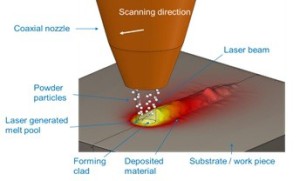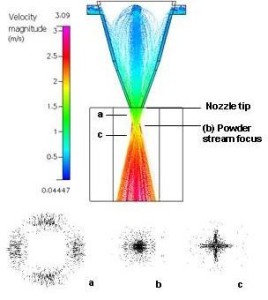 Challenges of Simulating Additive Manufacturing Equipment
Challenges of Simulating Additive Manufacturing Equipment
The ability to produce increasingly complex customized products led the growth of additive manufacturing (3D printing) in industry. With a single piece of equipment, powder and a CAD file, companies can decentralize their production and prototyping. Additionally, 3D printers have the ability to build products that cannot be made with traditional manufacturing processes.
“However, the lack of standardization, design rules, repeatability, production speed and quality control significantly hinders the expansion of 3D printing,” notes Mustafa Megahed, manager of CFD & Multiphysics Centre of Excellence at ESI Group. Simulating additive manufacturing mechanisms can go a long way to help bring 3D printing to the next level. Additive manufacturing technologies such as laser direct metal deposition (LDMD or blown powder additive manufacturing) involve the modelling of microscopic, mesoscopic and macroscopic scales.
“When simulating LDMD, you are dealing with particles in the order of 10 microns in diameter, a laser beam diameter of 1-2 mm, a work piece several centimeters long and a laser path that could be as long as a kilometer,” stressed Megahed. “If you were to simulate that all at once,” he added, “it would take more computing power than current high performance computing (HPC) could handle.” This multi-scale problem can be a challenge to simulate. Fortunately, ESI Group has developed a multi-scale, multiphysics solution to characterize the physics associated with additive manufacturing processes.
Multiphysics of an LDMD 3D Printer
 LDMD printers have a nozzle with two functionalities: dispersing the particles and adhering them to the substrate with heat.
LDMD printers have a nozzle with two functionalities: dispersing the particles and adhering them to the substrate with heat.
A laser focused through the central hull of the nozzle acts as the heat source. It melts the metal substrate and particles so they combine into a melt pool. The melt pool beads onto the substrate due to the surface tension forces.
The particles are dispersed from the outer ring of the nozzle. A carrier gas blows out of the ring and releases the metal powder onto the substrate. Particles that do not get hot enough to join the melt pool will impinge and bounce off of the substrate surface as material and energy losses.
Simulations are needed to optimize:
- Nozzle-to-substrate distance, to control particle deposition pattern
- Laser speeds, to control the melt pool
- Material properties of the final product.
Simulating a Multi-Scale Problem Like an LDMD 3D Printer
“The micro scale models of the LDMD simulation deal with the powder trajectory and the thermal cycle of the melt pool,” explained Megahed. The particle flow is modeled using Lagrangian tracking and the laser is simulated by the control angle discrete ordinate model. The model was extended to account for laser interaction with the particles (scattering and absorption). To simplify the computation, interaction between particles is ignored in-flight. The research teams at ESI and the University of Manchester found a middle ground between experimentally-measured powder particle temperatures and numerical predictions.
“The micro scale simulation is used to optimize the nozzle and process parameters to influence the melt pool shape, avoiding porosities or build defects. The thermal cycle is obtained as a by-product and is utilized in macro-models to determine the corresponding residual stresses,” explained Megahed. The results of the micro scale model will feed into the macro scale model. This simulation will determine the residual stresses and distortions created as the melt pool cools and solidifies. “The distortion is certainly not wanted because the final shape might not match the original design,” said Megahed. “Also, the residual stresses represent an internal load, leading to reduced load capacity of the material. These imperfections will also accumulate as the model builds and sections are heated and cooled multiple times.”
The mesoscale model looks into the overall metallurgical properties of the build. The results will be dependent on the alloy composition, temperature distribution, deposition patterns and residuals. Therefore, the micro and macro simulations interacts with the mesoscale model. Today, ESI’s CFD & Multiphysics Centre of Excellence uses metallurgical tools and data bases from their established metal-based manufacturing tools, such as ESI’s casting simulation suite, ProCAST, to generate these results.



